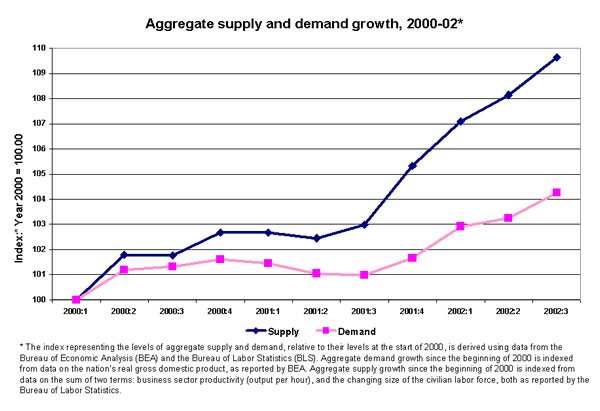Snapshot for December 18, 2002.
Why we need stimulus: Symptoms of a defective economy
On December 7, 2002, the National Bureau of Economic Research (the most respected arbiter of business cycle dating) announced that it could not declare the recession that began in March 2001 over. Of particular concern was the behavior of employment. The unemployment rate rose by .3% in the month of November to 6%, while the share of unemployed who have been out of work for longer than 6 months reached 20.6% percent. These worrying labor market indicators are signs that aggregate demand is lagging behind aggregate supply.

Aggregate supply refers to the productive capacity of the economy-how many goods and services could be produced if there were full employment of labor and full utilization of all factories. Aggregate demand is the actual purchase of goods and services by households, businesses, and government, minus net exports (net exports being exports minus imports). The graph above shows that the current problem is not insufficient capacity: the U.S. economy is fully capable of producing more. Productivity-how much each worker can produce-has been increasing just as quickly during the current recession as it was before; in fact, it has risen by over 7 percent since the first quarter of 2000. The problem is insufficient demand: businesses do not want to produce more, even though they could, because they do not think there are enough customers to buy their goods. Accordingly, business production has risen by only around 3 percent in real terms (taking account of inflation) since 2000. When capacity rises faster than demand, fewer workers are needed, which leads to rising unemployment. The U.S. economy needs a demand stimulus to increase production and employment To find out what a successful stimulus plan would look like, see the EPI Briefing Paper by Lawrence Mishel: Generating Jobs and Growth: An Economic Stimulus Plan for 2003.
This week’s Snapshot by EPI economist Josh Bivens.
Check out the archive for past Economic Snapshots.
Preferred Citation: Economic Policy Institute, “Economic Snapshots, [insert date].” Washington, D.C.: Economic Policy Institute, 2002.
